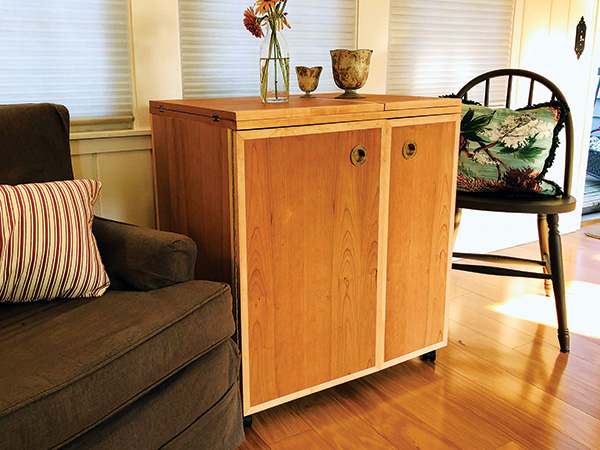
Much like woodworking, crafts such as knitting, gardening and sewing gained popularity as the pandemic caused people to spend more time at home. The satisfaction and fun of these home-based hobbies was enhanced by the utility of their results.
Crafters have found joy in the practical projects they have completed. In that regard, it’s been a true silver lining in an otherwise troubling time.
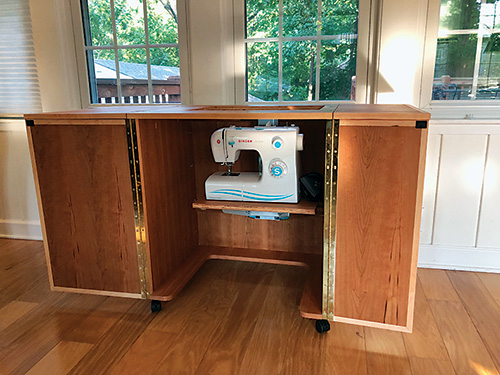
Here at the Journal, we’ve been watching the sewing trend, and some have asked us to create a practical sewing cabinet to meet the need. Here it is!
Cutting the Plywood
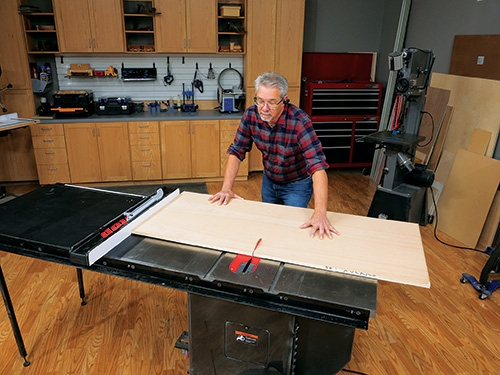
The cabinet is made mostly of 3/4″ plywood (you’ll need two 4′ x 8′ sheets) laid up in a cherry veneer, although the choice of veneer species is entirely up to you. The many solid lumber accents on our cabinet are made of maple, which evokes a Scandinavian design motif.
Take a close look at the Material List for the length and width of the various plywood panels. One important detail to note is that the top (Piece 1) is eventually cut into three panels. After you cut it to size and wrap it with maple edging, you will then crosscut it on the table saw to form the folding top leaves. One benefit to this approach is that it allows for the figure of the hardwood plywood to flow all across the work surface when the leaves are extended.
Rip and crosscut all seven of the project’s primary plywood panels. (I broke them down in advance using a handheld circular saw so that I could manage them more safely on the table saw.) For best results, use a sharp blade designed for cutting plywood. When you’ve completed that task, surface enough maple stock to prepare all the 3/4″ x 3/4″ edging you’ll need.
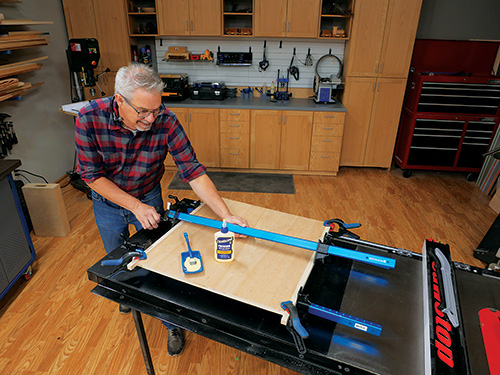
Starting with the back and side panels, cut strips of this trim extra long. The back panel receives two pieces of edging and the side panels get one piece each on their front edges. (See the Drawings for details.) Glue and clamp the edging in place. When the glue joints cured, I trimmed their ends flush with a fine-toothed saw.
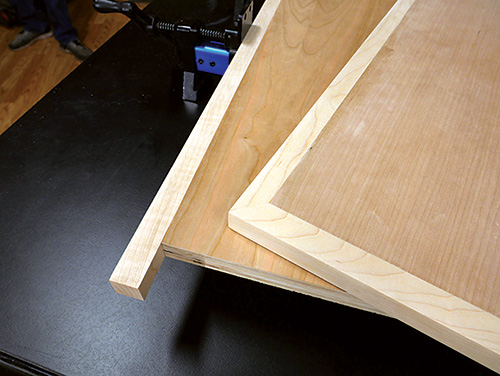
Install edging all around the top panel, then crosscut it into the large center panel and two leaves.
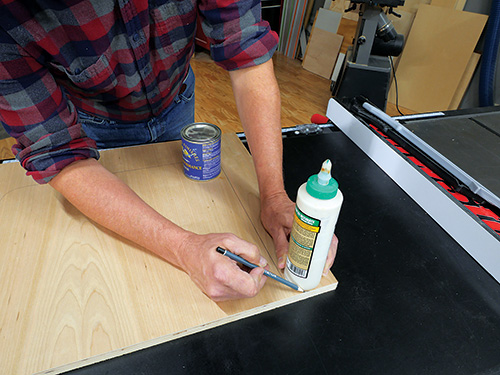
For both the top and door panels, I miter-cut the trim at 45 degrees to create a tidy and professional look. Take your time with this task. I cut and dry-fitted the four pieces of mitered trim for each panel one at a time to check the fit of the corner joints before gluing them in place.
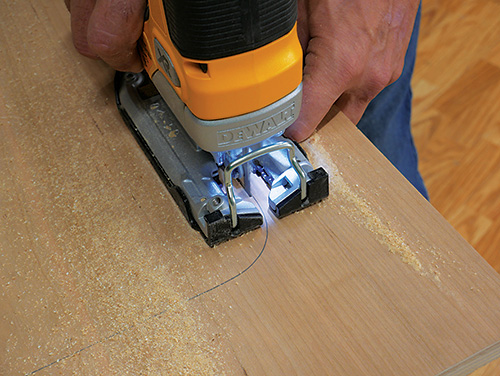
Now lay out the foot recess in the bottom panel, using the Drawings, and cut out this contour with a jigsaw. Sand the cut edge smooth. Apply peel-and-stick cherry veneer edging to cover this curved edge and the other exposed plywood edges that remain. Then it’s time to sand the edging flush to the plywood, being careful not to sand through the hardwood veneer.
Carcass Assembly
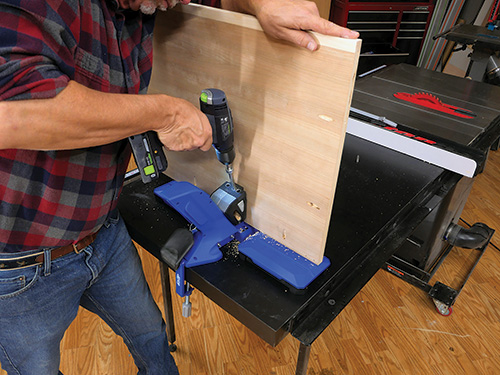
I decided to assemble the cabinet parts using pocket holes and screws. It is a fast, easy and strong joinery method that works particularly well for casework construction like this.
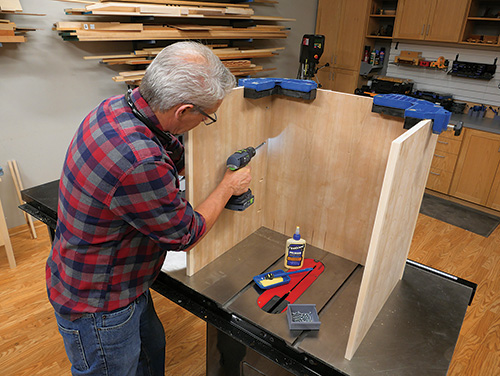
Bore the pocket holes and then, with a thin coat of glue on both faces of the joints, screw the back and side panels together. If you are working by yourself as I do, wrangling these three large panels into proper alignment could be a bit frustrating, especially with glue spread on the joints. To prevent that problem, I used a pair of Rockler’s Clamp-It® Corner Clamping Jigs to align the panels and act as a “third hand” during the process. I also used my table saw’s perfectly flat top to align the top of the plywood panels (the panels are upside down in the photo). Work smart, not hard!
I debated about whether to attach the casters at this point. Chasing the cabinet around the shop on its wheels as I continued to work on it would have been comical and frustrating. But the casters all lock, and the fact that I wanted them mounted before I hung the doors convinced me that now was the time.
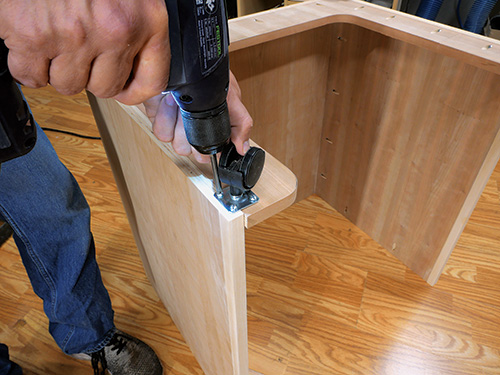
Speaking of timing, with the cabinet carcass assembled, now was also the time to make the lift supports. I used plywood for these parts, but you could use solid cherry lumber instead if you have some around your shop. Either way, these supports need to fit perfectly between the sides of the cabinet. Rip the supports to width and then measure their lengths off of the cabinet itself before cutting them to length.
If the supports fit well, bore two pocket holes into each of their ends. Then grab your pressure-sensitive edging and apply it to one long edge of one of the supports. Set them both aside for now.
Hanging the Doors
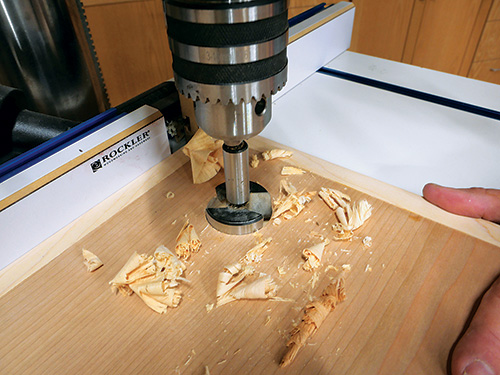
You’ve come a long way on this project, and next up we’ll hang the doors. Before doing that, lay out locations for the brass inset door pulls (see the Pull Location Drawing). Bore stopped holes for this hardware using a 1-3/4″-diameter Forstner bit.
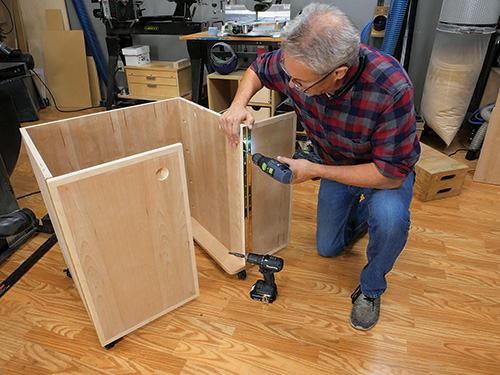
The doors are mounted to the cabinet on piano hinges. That’s because the top’s fold-up leaves are supported by the doors when the sewing cabinet is in use. And piano hinges, with their many, many screws are just the sturdy ticket for this task. But there is one inescapable fact about piano hinges: once fully mounted, they allow zero adjustment for door alignment. Zero.
The way I made certain the doors hung properly was by following these steps. First, I mounted the hinges to the doors with the hinge knuckle just past the front face of the door. I could then measure the exposed margin of the edge that remained uncovered by the hinge. Using that measurement, I marked a line down the edging on the cabinet sides.
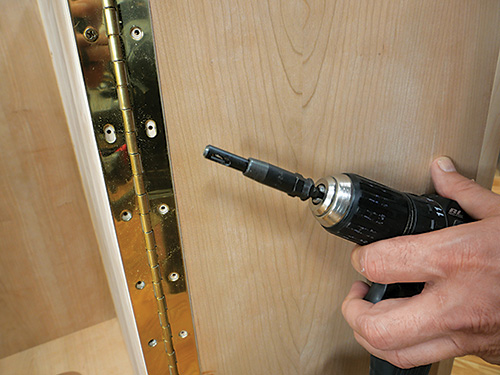
Now, using that mark to locate the hinge on the cabinet (and this is a place where a shop helper can be very helpful), I drilled one screw hole at the top of the hinge and one at the bottom. I then mounted the door with only two screws. I followed the same procedure on the other door.
If the doors are properly aligned, you should go out and buy a lottery ticket. If not, you can remove one of the screws holding the door in place, adjust the alignment and drill another screw hole. Do the same on the other door. Repeat until the doors align properly and then, using a self-centering drill bit, bore all the remaining screw holes. I finished up mounting the door by driving home all of the attachment screws. But if you prefer to apply finish first, you can remove the doors now and rehang them later.
Work Surface Details
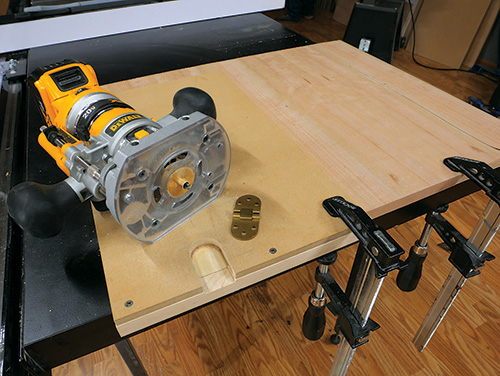
There are a few machining tasks to be done to the top/work surface next. First, install the sewing machine hinges. To do that, make a jig that helps you rout out the hinge mortises accurately. Using the Hinge Routing Template Drawing, lay out and cut the mortise shape into the edge of a piece of 3/8″ MDF. Then mount a 3/4″ x 3/4″ guide to the edge of the MDF with screws. Install a 5/16″ O.D. guide collar and a 1/4″ straight bit in your router. Test the jig’s accuracy on some scrap. If the hinge fits, you are good. If not, adjust the jig’s opening as needed.
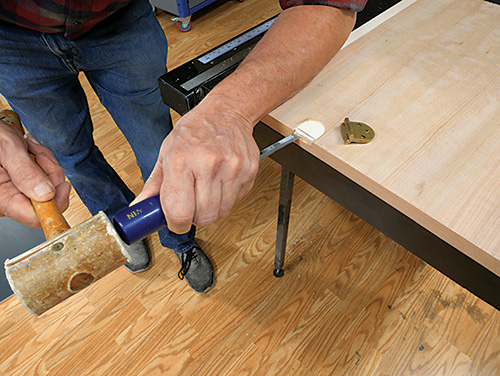
When the jig works correctly, rout the mortises in the top face of the center panel and leaves. Then chisel out the recesses for the hinge knuckles. Take your time with this, as the knuckle recesses will be visible when the top is folded up. I chose to mount the top to the cabinet at this point.
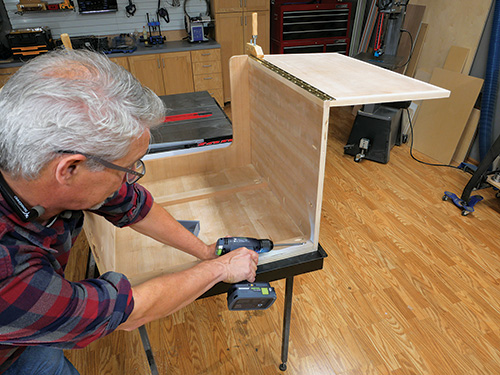
Remember those lift supports you made a while ago? Now is the time to mount them in the cabinet. Using the locations shown in the Drawings, first glue and screw the top support (without the edge tape) in place.
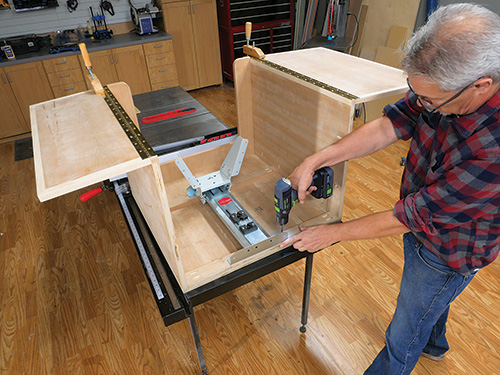
Then, with the covered edge oriented to the top of the cabinet, secure the second support with glue and screws. Attach the sewing machine lift hardware to the supports. The lift is adjustable; see the directions that come with it to fine-tune it.
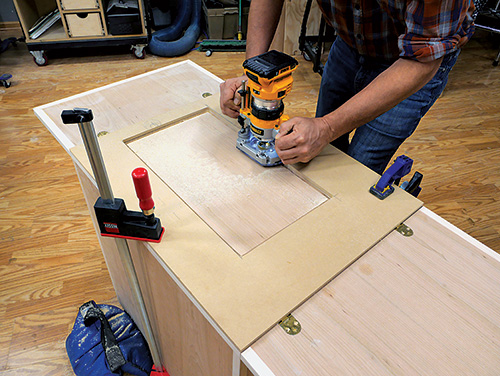
Next, you need to cut the sewing machine platform out of the center section of the top/work surface by routing a large opening in the center panel. Lay out this opening using the Top Construction Details Drawing. Grab another piece of 3/8″ MDF and cut an 11-1/8″ x 19-3/8″ rectangle out of it to create a cutting guide for the router. Then with the same router setup you just used on the hinges, rout down through the plywood to create the platform piece. I did this in several deepening passes.
Finishing Up
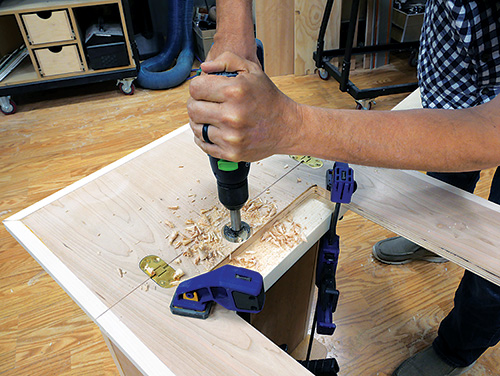
You are in the home stretch of the building process now! There is a need for the power cord and foot control cord to have access to the inside of the cabinet when the sewing machine is in use. To do that, I chose to drill a hole and cover it with a brass grommet. It’s a two-step process, as you need to sink the grommet’s top flush with the work surface. Use a 1-3/4″ diameter Forstner bit to bore a shallow recess for the grommet top, then switch to a 1-5/8″-diameter bit to drill the grommet’s through hole.
With that done, mount the magnetic catch that holds the doors closed. Leave off installing the inset door pulls until after you apply finish to the project. Sand the edges of the sewing machine platform and its opening smooth and break their edges with sandpaper.
Go ahead and mount the sewing machine platform to the lift, and you have completed this project’s construction steps. Give the entire cabinet a good sanding, working up to at least 180-grit.
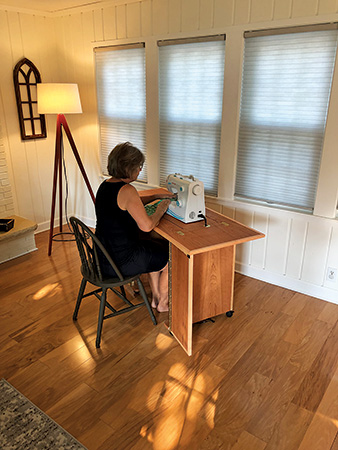
I chose Watco® Natural oil finish for this cabinet, and here’s why: few finishes pop the figure of cherry lumber or veneer like an oil finish. Four coats of Watco will create a beautiful finish. And if it should get scratched or distressed — this is a workstation, after all — it can easily be touched up.
Hard-to-Find Hardware:
Standard Twin Pin Sewing Machine Hinges (2) #26765
1-1/2″ x 60″ Slotted Piano Hinges in Brass Finish (1) #19308
Heavy-Duty Twin Wheel Locking Casters (1) #58907
Brusso® Solid Brass Recessed Pulls (2) #24618
Heavy-Duty Rockler Sewing Machine Lift Mechanism (1) #69191
Low Profile Magnetic Catch (1) #26542
Round Metal Grommet – Bright Brass (1) #30320





